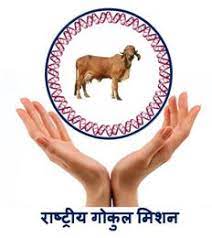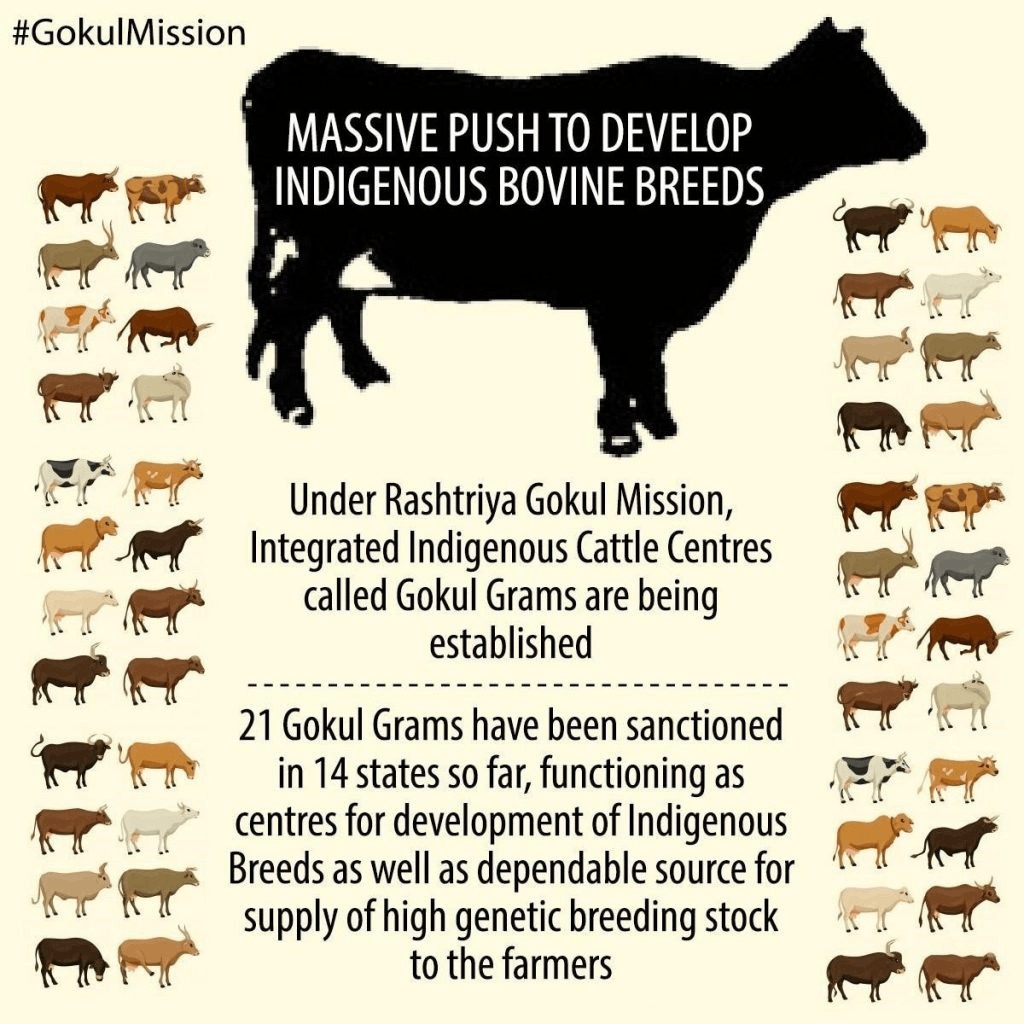
Rashtriya Gokul Mission
Rashtriya Gokul Mission
Important for Prelims Exam:
National Gokul Mission and related initiatives, National Livestock Development Scheme, Gokul Gram, Sahiwal Cow, Tharparkar, Lal Sindhi, Jersey, National Dairy Research Institute (NDRI), Krishi Vigyan Kendra
Important for Mains Exam:
Importance of promoting indigenous cattle breeds and their impact on employment generation and economic growth, Initiatives to promote livestock sector
October 30, 2023
Why in news:
- Recently, under Rashtriya Gokul Mission, priority has been given to improve the quality of Gir variety of cows among all the indigenous breed of cows.
‘Gir’ cow
- This is a cow of Indian origin which is found in South Kathiawar i.e. Gir forest area of Gujarat state, Maharashtra and surrounding districts of Rajasthan.
- Life span: The life span of this breed of cow is 12-15 years.
- Reproduction: Capable of producing 6-12 calves in a lifetime.
Specialty:
- This cow is known for high milk yield productivity.
- Gold elements are found in the milk of this cow which helps in developing immunity.
- Milk production capacity and adaptation of Gir cows is influenced by many factors of micro climatic conditions.
- For example, Gir cows grow in herds, hence their milk production reduces if they are reared separately.
Reasons for giving preference to improvement in Gir breed:
- Gir is a hardy, adaptable breed of cow with high milk yield and calm temperament; However, experts say that genetically superior cows should be identified and bred among all the indigenous breeds.
Impact of this Action
Impact on Livestock Numbers:
- According to the livestock census conducted in the year 2019, an increase of 70% has been observed in pure breed Gir cows since the year 2013. Whereas, other indigenous breeds like Sahiwal and Haryana recorded a decline in their numbers.
- This action may reduce the diversity of indigenous cattle breeds in India.

Rashtriya Gokul Mission:
About this
- Implemented since December 2014, this mission focuses on the development and conservation of indigenous cow breeds. The scheme will continue from 2021 to 2026 under the National Livestock Development Scheme with a budget outlay of Rs 2400 crore.
- The objectives of this scheme run by the Ministry of Fisheries, Animal Husbandry and Dairying are as follows:
- To increase cattle productivity and sustainable milk production by using advanced technologies.
- To promote the use of bulls with high genetic merit for breeding purposes.
- Expand artificial insemination coverage by strengthening breeding networks and providing services at the doorstep of farmers.
- To promote scientific and holistic conservation of indigenous cattle and buffalo husbandry.
Significance of this mission:
- Benefit to Farmers: This will benefit all cattle and buffalo farmers in India with a special focus on small and marginal farmers.
- Increase in milk production: This scheme will boost milk production and productivity.
- Conservation and Development: It focuses on the conservation and development of Indian breeds of milch cattle.
- Dairy Infrastructure Establishment: The Mission seeks to establish dairy infrastructure to enhance processing, acquisition and marketing.
- Women Empowerment: This initiative will empower women in particular.
- Currently more than 70% of livestock work in the country is done by women.
Components of this mission:
- Availability of high genetic merit germplasm.
- Expansion of artificial insemination network
- Development and conservation of indigenous breeds
- Skill development
- Farmers' awareness
- Research Development and Innovation in Bovine Breeding
Implementing agency
- All initiatives related to Rashtriya Gokul Mission are implemented through the State Implementing Agency (SIA i.e. Livestock Development Board).
Important Initiatives of Government of India under Rashtriya Gokul Mission:
- Animal development centers called Gokul Gram have been established to develop indigenous breeds.
- Introduction of awards like Gopal Ratna and Kamdhenu to encourage farmers to rear indigenous breeds.
- To establish National Kamdhenu Breeding Center (NKBC) as a center of excellence.
- To create an e-market portal 'e-Pashu Haat - Nakul Prajan Bazaar' connecting breeders and farmers.
- Launch of Pashu Sanjeevani animal welfare programme, providing animal health cards.
- Adoption of advanced reproductive technologies such as in-vitro fertilization (IVF) and multiple ovulation embryo transfer (MOET).
- Establishment of National Bovine Genomic Center (NBGC-IB) for indigenous breeds.
About Gokul Gram:
- Gokul Grams are integrated indigenous cattle centers aimed at promoting scientific husbandry and conservation of indigenous cattle.
- These centers focus on using indigenous breeds for high-genetic-merit bull propagation, adopting modern farm management practices and promoting common resource management including economical use of animal waste. India, which has 14.5% of the world's cattle population, has 83% indigenous cattle.
Solution:
- According to experts, emphasis should be laid on identifying genetically superior indigenous breeds of cows and increasing fertility rather than a few high milk yielding cattle breeds.
- The Animal Husbandry Department of Maharashtra conducted a successful application in 2012-14 by making semen of genetically superior indigenous breeds accessible to cattle sheds, which shows the potential of this approach.
- Frequent crossbreeding of cows should not be done as different breeds of cows are adapted to specific regions in India. In such a situation, there is a possibility of extinction of area-specific traits in cows of classified varieties.
- For example, crossing Badri cows of Himachal Pradesh and Uttarakhand with Gir cows may increase milk production, but may lead to physical changes, which should be avoided.
- Experts caution against repeating the mistakes of the White Revolution, in which foreign breeds like Jersey were imported for crossbreeding with Indian cattle breeds.
- Although this increased milk production, it did not increase the income of cattle farmers, as cross-breed cows were more susceptible to diseases and required more care.
Conclusion:
- In recent years, Rashtriya Gokul Mission has been playing an important role in increasing the sustainability and productivity of cow breeds. Since the corrective initiatives of this Mission have been very limited, Gir cows have become a problem for the farmers in Vidarbha region due to lack of adequate resources and support, there is a need to make this Mission universal.
Source: Down to Earth
-----------------------------------
Mains Exam Question:
Livestock rearing has great potential for providing non-agricultural employment and income in rural areas. Discuss and suggest suitable measures to promote this sector in India.